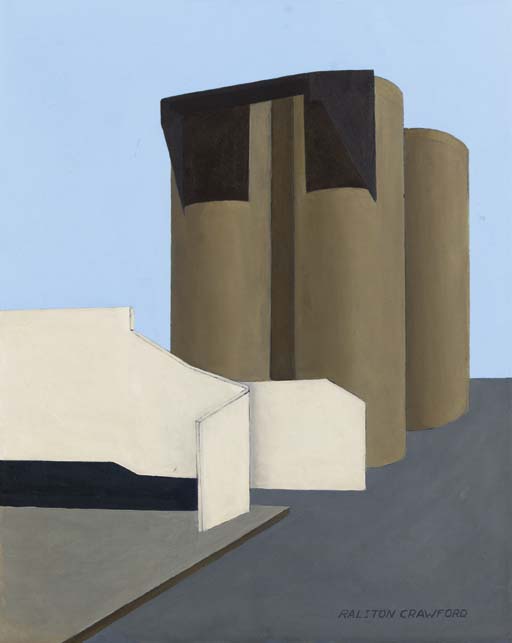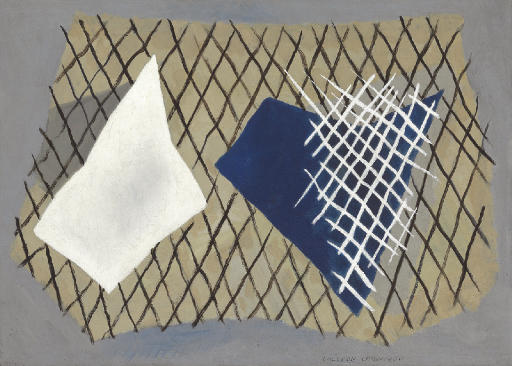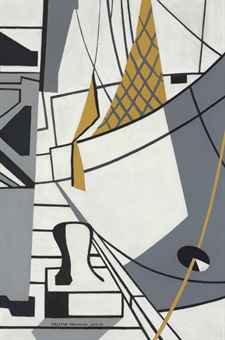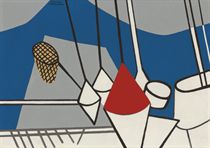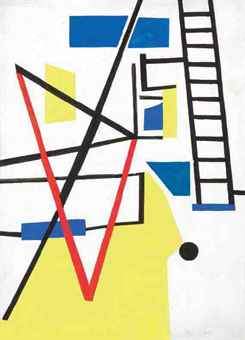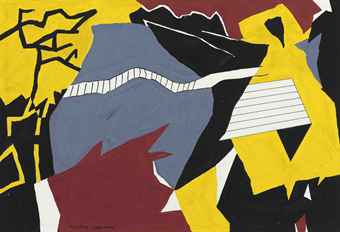Biography
Courtesy of Menconi + Schoelkopf (images added)
Recognized as one of the great innovators of Precisionism in the 1930s, Ralston Crawford grew well beyond his early visions of America flexing its newly industrialized muscles. In his later years he grew increasingly concerned with the process of painting as an abstract process, his mature works dealing with a deeper interrogation of the same scenes as some of the shine wore off them. Working and reworking in various media, Crawford at mid-century produced semi-abstract compositions, maintaining always a strong practice of observation.
Courtesy of Menconi + Schoelkopf (images added)
Recognized as one of the great innovators of Precisionism in the 1930s, Ralston Crawford grew well beyond his early visions of America flexing its newly industrialized muscles. In his later years he grew increasingly concerned with the process of painting as an abstract process, his mature works dealing with a deeper interrogation of the same scenes as some of the shine wore off them. Working and reworking in various media, Crawford at mid-century produced semi-abstract compositions, maintaining always a strong practice of observation.
Ever an innovator, he broadened and deepened the dialogue of post-war American painting where his colleagues remained entrenched in established styles. His experiments with silkscreening and graphic arts helped him to clarify a slick, almost Pop quality. His attentions, however, were bent not to the shiny and new, but also to the collapsing and decaying. His photographs of jazz musicians have been celebrated and his crisp modernist paintings are in important public and private collections, including the Museum of Modern Art, the Whitney Museum of American Art, and the Metropolitan Museum of Art. When he died at 71 in 1978, he had influenced several generations of American artists.
Early Life
The son of a ship captain, George Ralston Crawford was born in Ontario in 1906. Though his father would soon trade in the masts and riggings for insurance and real estate sales, young Ralston would forever identify with the transient life of the sailor. He move to New York with the idea of enrolling at the Pratt Institute, but apparently found work on a fruit company boat bound for South America instead. He spent six months traveling with the United Fruit Company on board La Perla, and the affair left its mark: he would retain a Kerouac-like attitude of “may as well travel” for the rest of his life. Following his impulse to travel, he hitched a ride again on La Perla through the Panama Canal and up to Los Angeles. (Haskell, pp. 10-11) There, he enrolled in art classes at the Otis Art Institute. Otis’s curriculum, along with a side gig at Walt Disney Studios, did the double duty of imbuing his aesthetics with a flavor of commercial illustration, while simultaneously confirming that the life of a commercial artist was not for him. The winds shifted after two years in LA, and he was off to pursue the life of the fine artist, this time in Philadelphia.For Crawford, 1927 was the right moment to be in Philadelphia. He enrolled at the Pennsylvania Academy of Fine Arts, which had then the same reputation it does now: a conservative institution, it taught the young Crawford what a fine artist is and does. Important, too, was the Barnes Foundation, which had opened its doors only five years earlier. There Crawford found the now world-renowned collection of post-Impressionist painting a stimulating solution to the contradictory pulls of Thomas Eakins and Walt Disney. Cézanne in particular influenced him. Some of the works that survive from this period demonstrate not only a superficial fascination with Cézanne’s plastic form method of building a volume and space, but also a profound appreciation for the adroit manipulation of space in tension with the picture plane. (Harnsberger, p. 79)
(Illustration: Still Life, Fruit on Table, c. 1931).
Already by 1930, Crawford had appropriated the master’s technique of subtly modulated brushstrokes to create vibrating forms. Back at the Academy, the influence of one of the few remaining modernist members of the faculty, Hugh Henry Breckenridge, also pressed home the chromatic lessons of the master of Aix. Breckenridge was an attentive disciple of Cézanne, and his students included some of the artists with whom Crawford would be associated in the 1930s, including Charles Demuth, John Sloan.
Precisionist Years
For the Precisionists, the stamp of Cézanne was refracted through a uniquely American lens. Cotemporaneous with the broad acceptance of Cubism and with the development of Futurism, the American movement retained a flavor quite distinct from its European counterparts. It should be remembered that the Precisionists in general, and Crawford in particular, were encountering the European vanguard all at once. The post-Impressionists were on view for the first time to American audiences about the same time as Picasso and Braque, along with the multitude of abstract movements of the 1930s. Secondly, the idea of industrial modernity had a very different ring in Pennsylvania than it did in Paris. The connections to cubism are clear enough: they shared crisp edges and sharply delineated planes, views broken up into a multitude of flattened forms. But the American works from the twenties and thirties lacked the dour colors of Braque and Picasso’s analytic cubism, and, while the Parisians were staring down café tables and small groups of figures, Demuth, Dickinson, and Crawford were almost entirely prepossessed with industrial subjects. The staying out of doors and more colorful palette, as well as the handling of space, owed as much to Cézanne as to the cubists and the futurists.The features of his work that bound Crawford with the Precisionists were personal, rather than the symptom of a shared manifesto; Crawford liked movement, but not necessarily movements. The precise lines of his work proved very effective in the depiction of the sharp-edged architecture of industrial buildings, and so form and content seemed to support one another. Peculiar to Crawford was a special attention paid to silos and elevators. Given Cézanne’s love for cones and cylinders, Crawford had identified in the American landscape the perfect form: a grain silo is just a cone atop a cylinder. Also from Cézanne, Crawford’s work in the thirties activates the sky as a planar, modulated form. Whereas there are precious few skies depicted in cubist paintings, Crawford and his cohort almost never failed to include the sky. But while Demuth would divide up the sky using invented lines—the imagined extensions of lines of architecture— Crawford found novel graphic devices to compose his canvases. As his work in the 1930s progressed, his canvases became more composed. The barns that once stood peacefully centered in the scene gave way to arrangements of foreground elements that ran off the canvas in all directions. By the end of the decade, he had mastered the technique, activating the canvas as a flat and dynamic form.
A major success of the period came with 1939’s Overseas Highway. At first glance, it is a simple exercise in one-point perspective: a pair of lines narrowing to a vanishing point on an unobstructed horizon. Upon closer inspection, however, the painting’s zipping speed is the product of subtle asymmetries and clever balances. The guard rail that seems to reach high above the viewer’s head achieves that studious division of the sky that Crawford elsewhere achieved with dangling ropes and powerlines. The vanishing point itself is off of center in both, and the peculiar placement of the point of view and the commitment to the parallel lines of the pavement bring the road swelling up to meet us, as if we are already on our way. Combining many techniques, it was a breakthrough for the painter. Overseas Highway feels fresher and more modern than his Precisionist forbears, as if the art world is being launched along with the viewer into a cool new future, headed toward the horizon at high speed, the Depression behind, an uncertain but bright future ahead.
The Atomic Age
The paintings of the early 1940s took the successes of Overseas Highway and ran with them. Canvases were now now filled to the brim with shapes. A boat that once sat nicely in the harbor suddenly fills the entire view inAt the Dock.
The industry that was building the country up for war was now an unignorable presence. That presence was not limited to Crawford’s work, as by 1942 he had been drafted for the military. In this regard, Crawford’s age played a large factor in distancing him from his colleagues of the thirties. He was old enough to be accepted as a significant force in American painting, but not old enough, like Demuth and Sheeler, to avoid service. Not a little did he dislike the sacrifice of these prime years of his career, dutifully he went. Cut off as he was from art-making, he found his way into the Visual Presentation Unit, where he produced, among other graphics, maps showing predicted weather patterns. (Haskell, p. 62) Though he regretted the sacrifice, the weather maps provided some new insights, and indeed, when he was invited to join the stable of Edith Halpert’s Downtown Gallery in 1943, the weather maps were shown alongside his oils. After all, a map is just an abstracted landscape, with the plane of the land tilted radically upward. Along with the rest of his work, the maps garnered favorable attention as well as several graphic art commissions, not least from the magazine Fortune.
After several covers and interior illustrations, Fortune bestowed upon the freshly-minted veteran the distinction of being the sole painter to witness the first public test of a nuclear bomb. On the first of July, 1946, Crawford witnessed the detonation of two nuclear weapons on Bikini Atoll. The bright, glaring work that Crawford produced in response to the event were among those that signaled a shift in his work. A depiction of the power and brilliance of the explosion itself, the work for the first time lacked clear connection to its subject matter. If it was a beginning of a new phase for Crawford, the birth of the atomic age was also a new beginning for a generation of American painters. In this, Crawford’s fear of being out of step came partially true: the power and anxiety of the living under the specter of the bomb was better depicted by the abstract expressionists than by Crawford’s still somewhat comfortable images. They are powerful, but not dreadful or awful, the way Pollock’s work sometimes is. If the explosive power of
Tour of Inspection (1946, Ralston Crawford Estate) failed to capture a generation’s anxieties, Crawford emerged from the war a changed artist.
Crawford’s commitment to observation, rather than expressionistic outpourings or symbolism, was unshaken –in fact, he redoubled his efforts. By deepening his observation, he began to find new entryways into the picture. He began to embrace new media, returning to a single scene with a crayon, with oil, with silkscreen, experimenting with the ways in which different media brought out different forms. His paintings benefited from the way silkscreening emphasized flat, bright planes of color, as well as from his renewed interest in drawing in pen and ink. But chief of among these tools of innovation was his early adoption of photography.
Ralston Crawford was not alone among painters adopting photography. His fellow Precisionist, Charles Sheeler, had made experimental films, both as independent works (with Paul Strand) and as source material for his paintings. But in the decades since the abstract film Manhatta, photography had grown more independent as an artform, and more practicable as a craft. As Vince Alletti wrote: “The best of these teeter provocatively between documentation and abstraction, anticipating similarly tough work by Robert Adams and Lee Friedlander.” (New Yorker, April 16, 2007) In his post-war pictures, Crawford increasingly embraced the sharp, graphic edges and non-local color. Having photographs handy in the studio allowed him to crop the image to isolate forms and remove elements that would identify scale and location. The forms in his paintings, in this way, became unmoored from their circumstances. Because of photography, some elements became more certain; because of his painterly flattening and removal of detail, the pictures became even more abstract.
The close of the 1940s also marked the beginning of the artist’s thorough engagement with the sounds of New Orleans. Though he had previously traveled to the Big Easy in 1926 and again in 1938, by the early fifties it had become a second home to a man who may have had trouble naming his first. New Orleans is considered the birth place of jazz, and had developed and long maintained unique sounds and performance customs, from the “second line” marching bands and the syncopated march-beat, to multiple lines of improvisation and call and response. The city remains a melting pot of cultural influences, and the music and culture surrounding the music had a unique flavor that appealed immensely to Ralston Crawford. At a time when such mix was not socially acceptable (and, in some circumstances, illegal), Crawford dug deep into the city’s jazz clubs and back rooms.
Jazz
The lifeblood of New Orleans, jazz was not simply a spectator affair. While the 1950s saw the profile of jazz rising in New York as a form of high art, it retained in New Orleans its vibrant connection to life in the streets. Just as bar patrons are free to wander into the street with a drink in their hands, the jazz musician was not a prisoner to the stage, the sound and spectacle mingling with all the other aspects of life—including the end of life. Death, in New Orleans, is a decidedly above-ground affair.The city’s high water-table demands that the dead be interred literally above ground, in mausoleums, or else risk being disinterred in the next flood. And what elsewhere might be an occasion for solemnity is in New Orleans closer to a celebration; drawing from Louisiana tradition of military brass bands and African and Creole rhythms, the “jazz funeral” features a procession from the home or church of the deceased to the cemetery. Typically the first leg of the jazz funeral is staid and sober, the band playing hymns and spirituals, giving way later to the more famous upbeat numbers like “When the Saints Go Marching In,” and “Didn’t He Ramble” after the body of the deceased is interred. With a song structure based on hymns, New Orleans jazz features call and response as well as a loose form allowing multiple musicians to improvise on the melody simultaneously, while the beat deviates from a metronomic march to an off-kilter syncopation.
Thus did Crawford’s focus return toward the cemetery. His paintings of headstones and mausoleums are not, however, somber meditations, but are infused with the swing and life of a street jazz band. They offer visual parallels to the features of the music that so inspired him: theme and variation, off-center soloing and call and response. As he reworked images in various media, the identifiable theme of the pictures comes in and out of focus, not unlike the melody of a jazz composition. Elements from one painting may crop up, unannounced but perfectly harmonized in seemingly unrelated works, as in Third Avenue Elevated, (1949, oil on canvas 29 ¼ x 40 1/8 inches Walker Art Center) and Nets with Red.
Ralston Crawford thought about his paintings at times explicitly in these musical terms:
“I am very much interested in a kind of pictorial counterpoint—the juxtaposing of one melody or theme in relation to another , or to several. It is out of this argument or contrast that I believe interest is created in pictorial structure. This must be part of the total plan – I am uninterested in producing the decorative.”
(As quoted in Agee, p. 45)
Crawford’s theme or melody would be a particular industrial scene. Like a line of melody for a jazz musician, that melody could then be transposed into another key, bent out of shape, and inserted into an improvised moment in an entirely different tune. Finding a literal connection between visual and musical form has preoccupied many painters and musicians, from Wassily Kandinsky and Arthur Dove to Claude Debussy and Charles Mingus—but Crawford was unconcerned, as ever, with being literal. He saw the active interpretation of found forms into paint as metaphorically linked to a piece of music through melody and improvisation.
Later Years
Though his attention to industry and sleek machines never faded, over the years the artist’s interest shifted from the shiny and new to the crumbling and scarred. Racecars, always a fascination, gave way to scrap-heap cars; high gloss magazines were replaced with peeling posters and illegibly torn signs. Siskind and Evans would treat similar subjects in strictly formalist terms, but Crawford invested his images with more meaning. One of the artist’s sons has pointed out the possibly grim undertones of these mounting symbols later in his father’s life: car wrecks, crumbling builidings, time-worn tombstones and blistering billboards. (personal correspondence) The pictures themselves retain the brightness and clarity of earlier days, so if there is something to this growing sense of death and destruction, it is approached with a frankness that seems quite in keeping with the artist himself.“I went to this junk pile many times. In truth, the shapes I found there were indeed more interesting than the new cars. The unpredictable relationships of broken, torn and twisted automobile parts, plus the startlingly unique equality of the individual shapes called for all of my attentiveness. In my continuing line of consciousness they were of course related to the plane wrecks of World War Two and to my recollections of Bikini, where I saw Test Able.
The positive nature of seeing transcended the dreary connotations of these shapes. In short, my reaction was one of extreme pleasure. I am quite certain that this picture will in no way affect the automobile accident rate. Such motivation is out of my field. But I will be pleased if it provides for the person seeing it some of the satisfaction that I got from viewing the wrecked cars.” (as quoted in Agee, p. 46)
Ralston Crawford died in Texas in 1978. His legacy as one of the luminaries of Precisionism retains its luster, and he has become increasingly esteemed as a proto-pop artist and a photographic documentarian. Ultimately, his work stands as a lasting invitation to the pure joy of looking, and seeing. For his love of the city of New Orleans and the music of its streets, Crawford decided to make the city his final resting place. Apropos of a life spent on the road, his cemetery monument is engraved, after the old jazz funeral standard, “Didn’t he ramble.”
Christie's 2006
Pr.$180,000
Christie's 2008
Whitney Musuem
Menconi + Schoelkopf
Ralston Crawford
Bora Bora No. 2, 1975
Oil on canvas
30 x 40 inches
Signed lower left: RC
Ralston Crawford
Signs, 1973-76
Oil on canvas
30 x 40 inches
Signed at lower left with initials: RC
Ralston Crawford
Coal Car, 1945
Gouache on paperboard
8 x 12 inches (image)
20.3 x 30.5 cm (image)
11 x 15 inches (sheet)
27.9 x 38.1 cm (sheet)
Signed at lower left: RALSTON CRAWFORD
Ralston Crawford
St. Ann Street, 1954
Oil on canvas
24 x 18 inches
61 x 45.7 cm
Signed at lower left: RALSTON CRAWFORD
Ralston Crawford
Nets with Red, 1956
Oil on canvas
19 1/2 x 25 1/2 inches
49.5 x 64.8 cm
Signed at lower right center: RALSTON CRAWFORD
Ralston Crawford
Masts and Rigging, 1975
Oil on canvas
40 x 30 inches
101.6 x 76.2 cm
Ralston Crawford
The Sails No. 5, 1956
Oil on canvas
26 x 40 inches
66 x 101.6 cm
Signed and dated on stretcher: Ralston Crawford / Started Apr. 17, 1956
Ralston Crawford
Box Car, 1941
Watercolor on paper
12 x 16 inches
30.5 x 40.6 cm
Christie's 2008
Whitney Musuem
Menconi + Schoelkopf
Ralston Crawford
Bora Bora No. 2, 1975
Oil on canvas
30 x 40 inches
Signed lower left: RC
Ralston Crawford
Signs, 1973-76
Oil on canvas
30 x 40 inches
Signed at lower left with initials: RC
Ralston Crawford
Coal Car, 1945
Gouache on paperboard
8 x 12 inches (image)
20.3 x 30.5 cm (image)
11 x 15 inches (sheet)
27.9 x 38.1 cm (sheet)
Signed at lower left: RALSTON CRAWFORD
Ralston Crawford
St. Ann Street, 1954
Oil on canvas
24 x 18 inches
61 x 45.7 cm
Signed at lower left: RALSTON CRAWFORD
Ralston Crawford
Nets with Red, 1956
Oil on canvas
19 1/2 x 25 1/2 inches
49.5 x 64.8 cm
Signed at lower right center: RALSTON CRAWFORD
Ralston Crawford
Masts and Rigging, 1975
Oil on canvas
40 x 30 inches
101.6 x 76.2 cm
Ralston Crawford
The Sails No. 5, 1956
Oil on canvas
26 x 40 inches
66 x 101.6 cm
Signed and dated on stretcher: Ralston Crawford / Started Apr. 17, 1956
Ralston Crawford
Box Car, 1941
Watercolor on paper
12 x 16 inches
30.5 x 40.6 cm




